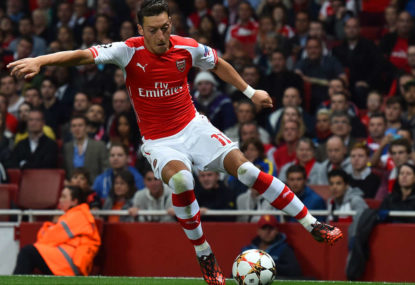'Arsenal aren't able to deliver': Former Gunner's brutal honesty after Champions League exit
Bayern Munich scored the only goal to defeat Arsenal 1-nil and progress to the semifinals. Former player Martin Keown says it's disappointing his former…

Mesut Özil is a playmaker, a footballing wizard, an unlocker of defences. Whatever you want to call him – an enganche, a trequartista, a number 10 – he plays the part of the diminutive creator on the footballing stage.
Ask him to open his trenchcoat, and you’ll see dinks, through balls, thunderbastards, Hollywood passes and the seal dribble all in his arsenal.
But there are lot of things you won’t see. He won’t be particularly proficient at tackling, or shot-stopping, or heading.
I mean, he might be skilled in all those areas, but that’s beside the point: he wasn’t bought for those skills; he was bought to create goal-scoring chances using his invention in an advanced position. Years playing matches and hours training under the careful gaze of coaches have been spent practising this role and honing his natural talents.
In recent days, the German has professed his disdain for playing on the left, the position he took up playing for his country at the World Cup just past. He believes he’s “one of the best players in the world” playing fashioning goal-scoring opportunities for the forwards.
“Fans, coaches, players and everyone knows that my best position is playmaker,” the 25-year-old told the English newspaper The Telegraph.
“It’s different playing on the left. When I was in Madrid, I often played on the right. I enjoyed that because I’m left-footed and I was able to cut inside to give assists and get shots on target.
“On the left, it’s more difficult. If I do get past someone I’m still away from the danger zone, still on the flank, and it’s harder for me to find the final ball with my right foot than with my left…It’s not my favourite position but I was willing to play there for [Germany at the World Cup].”
Despite his protestations, Arsenal boss Arsène Wenger has played him on the left side of midfield in variations of a 4-5-1 in the last three Premier League games, away to Everton and Leicester and at home to Manchester City.
During the Manchester City game especially, the English commentators (and during the break, Mark Bosnich too) spent much of their time criticising Özil, essentially for playing poorly as a left winger. Their criticism mainly rested on Özil’s lack of tracking back and athleticism, two values highly prized by the now thankfully-reduced-but-still-prevalent, outdated and old fashioned English attitude to football.
Tellingly, their criticisms also display a misunderstanding of football tactics and associated managerial intricacies.
Wenger decided the best way to combat the Premier League champions was to forgo an advanced creator. Surely he would have known that Özil would be a defensive liability, having managed him for over a year now and being witness to his training ground performance in the many weekdays between matches during that time.
Presumably, Wenger would have countered this by instructing his central midfielders on the day (Aaron Ramsey, Jack Wilshere and Mathieu Flamini) to shift left when in the defensive phase of play to cover for Özil.
Wenger’s decision to start Özil at left-mid, with its obvious repercussions to Arsenal’s defensive shape, was incredibly strange considering Arsenal’s weakness to direct attacks down their flanks, superbly exploited by Everton in their 3-0 win the previous season. In fact, Manchester City’s first goal came from such an attack down their right flank.
Wenger’s decision is stranger in retrospect when you see that Jesús Navas, an out-and-out winger in the traditional British vein, was starting on the right of City’s midfield, with Pablo Zabaleta behind him at right-back (keeping the former starting Arsenal right-back of last year, Bacary Sagna, out of the first 11).
With Arsenal playing the under-performing Natxo Monreal at left-back, Man City had an overwhelming advantage on their right-hand side of the pitch before the game had even started.
The situation on Saturday hit home for me, as during my season playing football this winter, a similar situation arose in my team. A player whose strengths didn’t include tracking back and other defensive duties was castigated like Özil. Mark (not his real name) was told to play left wing, where he sort of played like a wide target-man, and expected to run up and down the side of the pitch.
While of course the contexts are completely different, us being local, unfit, rubbish and amateurs unlike Arsenal’s grouping of international super-skilled millionaire athletes, the point remains that working around the talent at one’s disposal is an integral aspect of the art of management. You wouldn’t expect a plumber to be a good international lawyer, or an engineer to be adept at acting.
Arsenal’s formation on Saturday and Özil’s role were never going to complement each other. Wenger persisted with it, and it’d be too far to hope for the stalwart who insists on playing Yaya Sanogo, to change his mind.
However, the commentators (and Mark Bosnich) didn’t pick up on this at all. For them, it was all Mesut Özil’s fault for not being someone he isn’t – a no-track-backer.
Not only does Özil not like playing there in an attacking, creative sense, he’s obviously a defensive liability. It speaks volumes of football’s general commentariat that they targeted a big-name player and constructed an over-simplified talking point around him (constructing narratives being their duty, of course).
This trope of football analysis is annoyingly all-too pervasive – but that’s another article for another time.